How to grow Adenium
An unusual and striking perennial succulent originating from semi-arid regions of the Arabian Peninsula and east to southwest Africa. Adenium requires temperatures of at least 15°C to thrive and is therefore best grown in a heated greenhouse or as a houseplant here in the UK.
Adenium is classed as a caudiciform succulent, meaning it stores water in a swollen stem base at the junction of root and stem. Each plant develops its own unique shape; some have a very low swelling, shaped like a pear; others may be more elongated, looking like a wine bottle. Irregular, smooth branches bear spirals of large, glossy, grey-green leaves at the tips, with bright red, pink or white flowers borne throughout summer. Adenium is a relative of the nerium, hence flowers bearing such a strong resemblance to this familiar Mediterranean shrub. The wonderfully descriptive common names ‘desert rose’ and ‘impala lily’ hint at the uncommon beauty of this plant when seen flowering in its natural habitat.
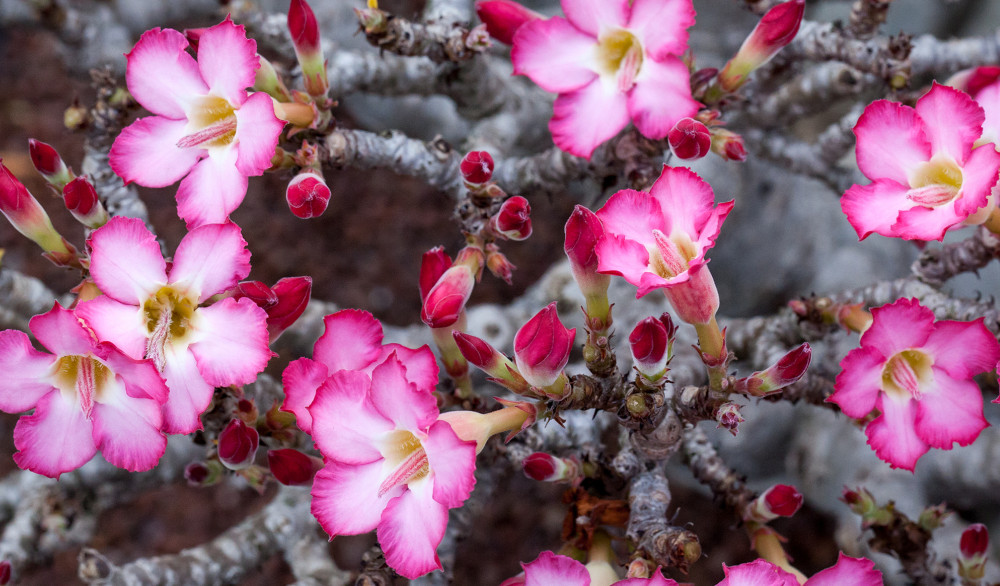
Key Information
Soil pH
Position
Hardiness

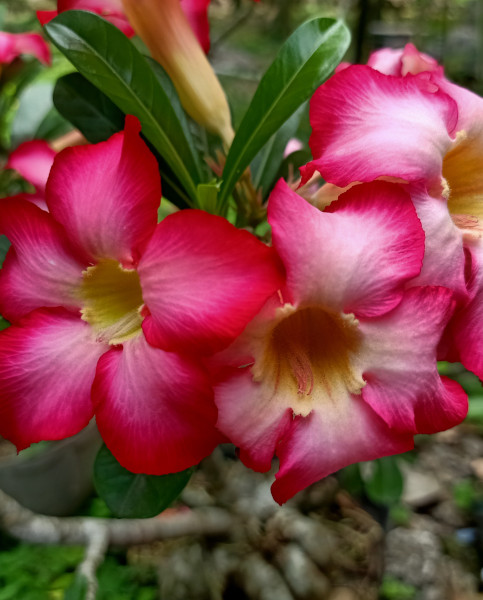
Where & when to plant Adenium
Spring is the best time of year to pot up permanently container grown plants, though with a watchful approach to watering it can be done throughout the year.
Ensure that your adenium is in full light, though not exposed to hot, direct sun. The following suggestions should help explain what is meant by this recommendation, which can seem a little vague and confusing.
Locate the plant in a light, south or west-facing room, somewhere other than in the window. This means it will receive high light levels, whilst not being in direct sun
Locate the plant in a light, south or west-facing room, on an area of the windowsill which only receives direct sunlight in the morning or evening
Locate the plant on a south or west-facing windowsill, with shading provided. A piece of greenhouse shade netting, or child’s car sunshade will work well
Locate the plant on a south or west-facing windowsill, and simply form the habit of moving it out of the hottest daytime sun during summer months
How to plant Adenium
Choose an appropriate container – large enough to hold the root ball with additional space to grow. Ensure there are plenty of drainage holes in the bottom
Use a loam-based potting compost, mixing in several handfuls of horticultural grit or sharp sand to aid drainage
Start with a layer of compost in the bottom of the pot, deep enough so that when sitting on it, the top of the root ball is about an inch beneath the top of the pot
Fill all space surrounding the root ball with compost, using fingers to firm in, avoiding looseness
Place on plant saucer if required
Soak well with water
A mulch with horticultural grit will look attractive and help to prevent a ‘cap’ or crust forming on the top of the compost (something which can happen to container plants as a result of watering)
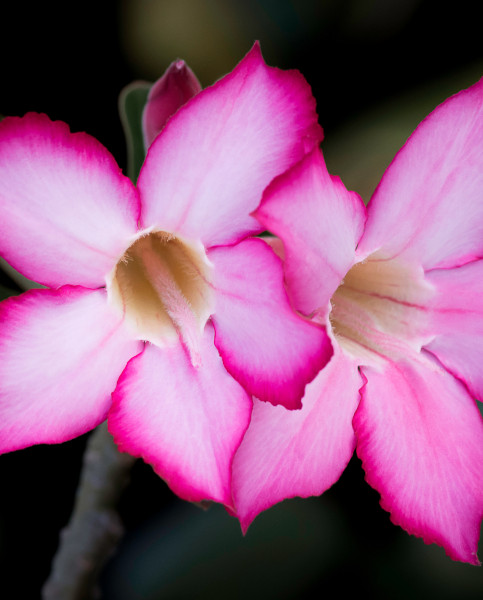
What to plant with Adenium
Adenium will contribute character, height, and colour to your collection of houseplants. For a stylish mix of texture and form, pair with our mix of succulents and a group of aloe.
If you would like any further planting ideas or growing advice for your adenium, please contact our friendly and knowledgeable Customer Care Team - we will be more than happy to help you.
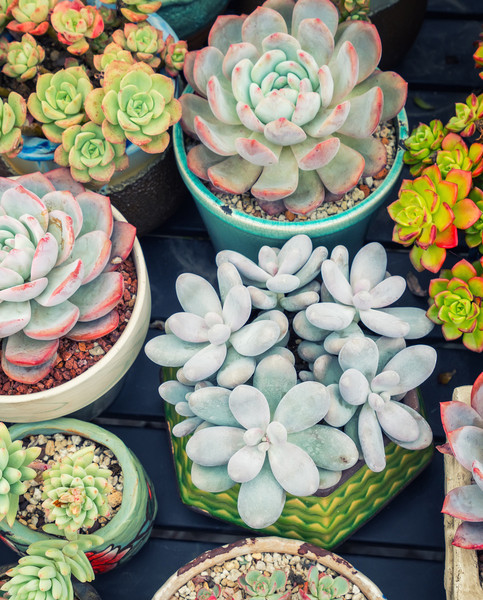

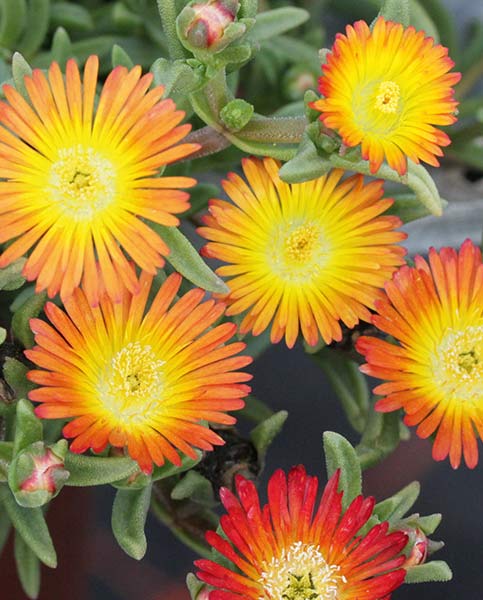
How to care for Adenium
Pruning and Deadheading
No pruning required
Watering
Water moderately during growth and more sparingly in winter. With this approach you are trying to mimic the natural conditions of adenium, whereby they will experience a rainy period (triggering growth), before entering a dry dormancy.
Apply a balanced liquid fertiliser 2-3 times during the growing period.
Cold Protection
Adenium is frost tender, and requires temperatures to remain above 10-15°C. The optimum temperature for healthy growth is 21°C.
Pests and Diseases
Adenium can be prone to aphids.
Aphids are small, sap-sucking bugs which form colonies on leaves and soft stems. An essential part of the wider food chain, aphids should be tolerated if possible. However, if present in numbers so substantial they distort growth, reduce vigour, and encourage the formation of sooty mould, you may wish to remove by organic means. This can be as simple as wiping off and squashing by hand, or regularly blasting off the plant using a jet of water from a hose.
How to propagate Adenium
Root cuttings from non-flowering shoots in summer, using bottom heat.
*Take care to avoid touching or ingesting the sap of adenium when taking cuttings (see ‘Common adenium questions’ below)*
- Select non-flowering shoots, cutting away from the plant using sharp secateurs. Take the entire shoot, stubs left on the plant will look unsightly
- Fill container/s with a perlite-heavy compost mix (at least 50% perlite)
- If leaves are large, cut in half with a sharp knife (to reduce water lost through transpiration)
- Insert cuttings into compost and water well. You can have several cuttings in the same container if there is enough space to do this without them touching
- Place in a heated propagating case at 21°C
- Keep compost moist, not saturated, until cuttings root; look for roots appearing out of the bottom of the container
- Gently remove from container, put into individual pots and grow on until large enough to put into permanent container.
Common Adenium Questions
Is adenium poisonous?
Yes, it is. Adenium exudes a milky sap from broken or cut stems which can irritate the skin and cause severe discomfort when ingested.
The leaves of my adenium look scorched. What has happened?
Despite being used to extremely hot, arid conditions, even a plant such as adenium can be damaged by the sun’s rays when received through the amplifying qualities of glass. Remove affected leaves and try moving to another location (as recommended above) or putting up shading.




